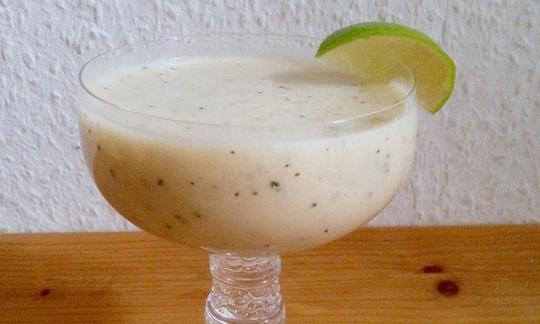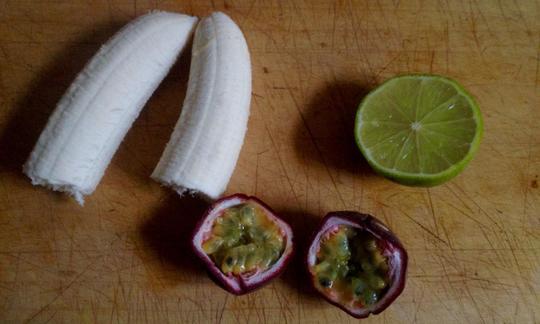Velvety Smoothie with Banana and Passion Fruit
raw-vegan
Ingredients (for serving, )
| 1 | Bananas, raw (organic?) (4.1 oz) |
| 1 | Passion fruit, purple, raw (organic?) (2.3 oz) |
| ½ | Limes, raw (organic?) (1.2 oz) |
| 200 ml | Drinking water, raw (organic?) (7.0 oz) |
Equipment
- hand-held blender / immersion blender or blender
- citrus juicer (lemon squeezer)
Type of preparation
- squeeze
- purée
Preparation
Peel the banana and place in the blender.
Cut the passion fruit in half, scoop the contents out with a spoon, and add to the banana in the blender.
It works best to use a sharp-edged teaspoon to scrape the seeds out.
Squeeze the lime and then drizzle the juice on top of the other ingredients. Purée together with 200 ml water until a creamy, velvety consistency is achieved.
Pour the drink into a glass of your choice, and if desired garnish with a slice of lime.
|
Nutritional Information per person
Convert per 100g
|
2000 kcal | |
|---|---|---|
| Energy | 179 kcal | 9.0% |
| Fat/Lipids | 0.92 g | 1.3% |
| Saturated Fats | 0.18 g | 0.9% |
| Carbohydrates (inc.dietary fiber) | 46 g | 17.0% |
| Sugars | 22 g | 24.9% |
| Fiber | 11 g | 43.5% |
| Protein/Albumin | 3.0 g | 5.9% |
| Cooking Salt (Na:28.3 mg) | 72 mg | 3.0% |
| Essential micronutrients with the highest proportions | per person | 2000 kcal | |
|---|---|---|---|
| Vit | Vitamin C (ascorbic acid) | 40 mg | 50.0% |
| Vit | Vitamin B6 (pyridoxine) | 0.51 mg | 37.0% |
| Elem | Potassium, K | 686 mg | 34.0% |
| Min | Copper, Cu | 0.19 mg | 19.0% |
| Vit | Folate, as the active form of folic acid (née vitamin B9 and | 36 µg | 18.0% |
| Vit | Biotin (ex vitamin B7, H) | 9.2 µg | 18.0% |
| Min | Manganese, Mn | 0.32 mg | 16.0% |
| Elem | Magnesium, Mg | 55 mg | 15.0% |
| Vit | Riboflavin (vitamin B2) | 0.18 mg | 13.0% |
| Vit | Niacin (née vitamin B3) | 1.8 mg | 12.0% |
Detailed Nutritional Information per Person for this Recipe
The majority of the nutritional information comes from the USDA (US Department of Agriculture). This means that the information for natural products is often incomplete or only given within broader categories, whereas in most cases products made from these have more complete information displayed.
If we take flaxseed, for example, the important essential amino acid ALA (omega-3) is only included in an overarching category whereas for flaxseed oil ALA is listed specifically. In time, we will be able to change this, but it will require a lot of work. An “i” appears behind ingredients that have been adjusted and an explanation appears when you hover over this symbol.
For Erb Muesli, the original calculations resulted in 48 % of the daily requirement of ALA — but with the correction, we see that the muesli actually covers >100 % of the necessary recommendation for the omega-3 fatty acid ALA. Our goal is to eventually be able to compare the nutritional value of our recipes with those that are used in conventional western lifestyles.
| Essential fatty acids | per person | 2000 kcal |
|---|---|---|
| Linoleic acid; LA; 18:2 omega-6 | 0.34 g | 3.0% |
| Alpha-Linolenic acid; ALA; 18:3 omega-3 | 0.04 g | 2.0% |
| Essential amino acids | per person | 2000 kcal |
|---|---|---|
| Tryptophan (Trp, W) | 0.01 g | 5.0% |
| Threonine (Thr, T) | 0.03 g | 4.0% |
| Phenylalanine (Phe, F) | 0.06 g | 4.0% |
| Isoleucine (Ile, I) | 0.03 g | 3.0% |
| Leucine (Leu, L) | 0.08 g | 3.0% |
| Lysine (Lys, K) | 0.06 g | 3.0% |
| Valine (Val, V) | 0.06 g | 3.0% |
| Methionine (Met, M) | 0.01 g | 1.0% |
| Vitamins | per person | 2000 kcal |
|---|---|---|
| Vitamin C (ascorbic acid) | 40 mg | 50.0% |
| Vitamin B6 (pyridoxine) | 0.51 mg | 37.0% |
| Folate, as the active form of folic acid (née vitamin B9 and | 36 µg | 18.0% |
| Biotin (ex vitamin B7, H) | 9.2 µg | 18.0% |
| Riboflavin (vitamin B2) | 0.18 mg | 13.0% |
| Niacin (née vitamin B3) | 1.8 mg | 12.0% |
| Pantothenic acid (vitamin B5) | 0.47 mg | 8.0% |
| Vitamin A, as RAE | 46 µg | 6.0% |
| Thiamine (vitamin B1) | 0.05 mg | 4.0% |
| Vitamin E, as a-TEs | 0.20 mg | 2.0% |
| Vitamin K | 1.3 µg | 2.0% |
| Essential macroelements (macronutrients) | per person | 2000 kcal |
|---|---|---|
| Potassium, K | 686 mg | 34.0% |
| Magnesium, Mg | 55 mg | 15.0% |
| Phosphorus, P | 77 mg | 11.0% |
| Calcium, Ca | 31 mg | 4.0% |
| Sodium, Na | 28 mg | 4.0% |
| Essential trace elements (micronutrients) | per person | 2000 kcal |
|---|---|---|
| Copper, Cu | 0.19 mg | 19.0% |
| Manganese, Mn | 0.32 mg | 16.0% |
| Iron, Fe | 1.6 mg | 11.0% |
| Fluorine, F | 145 µg | 4.0% |
| Zinc, Zn | 0.30 mg | 3.0% |
| Selenium, Se | 1.7 µg | 3.0% |
| Iod, I (Jod, J) | 3.2 µg | 2.0% |
Subtly sweet and velvety light smoothie with banana and passion fruit. Ideal as a refreshing drink alongside a meal or as a snack.
Passion fruit: Passion fruit is classified as a berry and is the edible part of Passiflora edulis. But you can also use the leaves of the plant to make medicinal remedies, for example, against inflammation. The oil obtained from Passiflora edulis seeds is used primarily for cosmetics. The plant originates from Brazil and Argentina. There are numerous other species within the Passifloraceae family, including Passiflora incanarta, whose leaves and roots are also used in traditional medicine (e.g., for calming). The tradition of using passion fruit and related species for medicinal purposes can be traced back to native American traditional medicine as well as the medicinal remedies of European settlers in North America.
Ripe passion fruit usually look somewhat shriveled and are very light in weight, which makes them appear almost hollow. They have a very unique and intense taste, which is why they tend to provide the dominant flavor in dishes.
Drinking smoothies correctly: It is best to drink smoothies with a wide straw. These are also available in glass or stainless steel. It is recommended that you drink your smoothie slowly so that the nutrients it contains can be better absorbed. And you shouldn’t forget that smoothies are more like a meal or a snack than a drink.
Lime substitute: Instead of the lime, you can also use a lemon. Since lemons don’t usually yield as much juice as limes, you may want to use more than one lemon.






